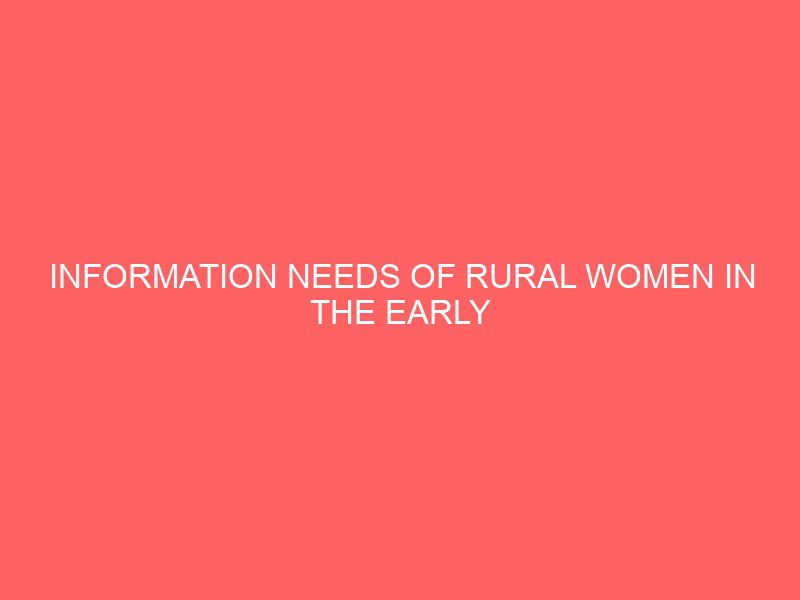Description
ABSTRACT
This study investigated information needs of rural women in the early detection of breast cancer in Orumba South Local Government Area of Anambra State, Nigeria. Descriptive survey design was adopted for the study. The population comprised three thousand, four hundred and eighty eight rural women from the womens Guild chapter of the Anglican Communion. The sample size comprised five hundred respondents, selected through proportionate stratified random sampling technique. Five research questions guided the study. One instrument, titled Breast Cancer Early Detection Information Need Questionnaire BCEDINQ was used for the study. Data obtained were analyzed using percentage and mean ratings. The major findings include that rural women have a critical need for information on early warning signs of breast cancer with mean scores of 2.40, 2.37, 2.36, 2.23 and 2.10; have very low awareness on general breast cancer facts with mean scores between 1.23 and 1.86 in fifteen questions; access breast cancer information mainly through community health centre 55; prefer certain media such as women group meetings 95.4, house-to-house visits by information providers 92.6, community based breast cancer counseling centre 90, public outreach campaign 86.8 and television 72.4; and factors such as ignorance, absence of functional library services, lack of adequate information mechanisms, negligence of the governments responsibilities to its citizens, inaccessibility of the rural areas by nongovernmental agencies, language barrier and illiteracy hinder their access to breast cancer information. Implications of the findings included inadequate propagation of breast cancer information as well as inadequate enforcement of such policy by the Federal Government through the health care delivery system; inability of rural women to actively participate in early detection due to inadequate information; and unavailability of suitable information media, which restricts access to such information. Recommendations were that the government should make breast cancer information propagation an enforceable integral part of the health care delivery system as well as set up a goal directed committee to strategically implement it; utilize the October National Breast Cancer Awareness month using key dates, pictorial displays, lectures, seminars and counseling; involve Librarians in such activities; intensified effort of nongovernmental organizations; establish various information media which should include public libraries; propagate breast cancer information through suitable media such as women group meetings, house-to-house visits by information providers, community based breast cancer counseling centre, public awareness campaigns; and the collaboration of all the involved authorities in alleviating the factors that hinder the women from accessing breast cancer information.
TABLE OF CONTENTS
CONTENTS PAGES
TITLE PAGE i
APPROVAL PAGE ii
ACKNOWLEDGEMENTS iii
ABSTRACT iv
TABLE OF CONTENTS v
LIST OF TABLES viii
LIST OF APPENDICES ix
CERTIFICATION x
DEDICATION xi
CHAPTER ONE: INTRODUCTION 1
Background to the Study 1
Statement of the Problem 9
Purpose of the Study 11
Significance of the Study 12
Scope of the Study 14
Research Questions 15
CHAPTER TWO: REVIEW OF RELATED LITERATURE 16
Conceptual Framework 16
Breast cancer 16
Early detection 24
Information need 29
Rural women 35
Theoretical Framework 38
Theoretical model of social information need 38
Theoretical Studies 45
Information needed by rural women in early detection Of breast cancer 45
Importance of awareness on early detection of breast cancer 48
Media of information access on breast cancer early detection 52
Preferred media for the effective propagation of breast
cancer among rural women 57
Factors that hinder rural women from accessing
information on breast cancer 61
Empirical Studies 66
Breast cancer awareness 66
Information needs of women in early detection of breast cancer 72
Summary of Literature Review 74
CHAPTER THREE: METHOD 76
Research Design 76
Area of Study 76
Population of the Study 77
Sample and Sampling Technique 77
Instrument for Data Collection 78
Validation of the Instrument 79
Reliability of the Instrument 80
Method of Data Collection 81
Method of Data Analysis 81
CHAPTER FOUR: PRESENTATION AND ANALYSIS OF DATA 83
Research Question 1 83
Research Question 2 85
Research Question 3 86
Research Question 4 88
Research Question 5 89
Summary of Findings 90
CHAPTER FIVE: DISCUSSION OF RESULTS, CONCLUSION
AND RECOMMENDATIONS 92
Discussion of Results 92
Conclusion 97
Implications of the Study 98
Recommendations 99
Limitations of the Study 101
Suggestions for Further Research 102
REFERENCES 103
APPENDICES 122








Reviews
There are no reviews yet.